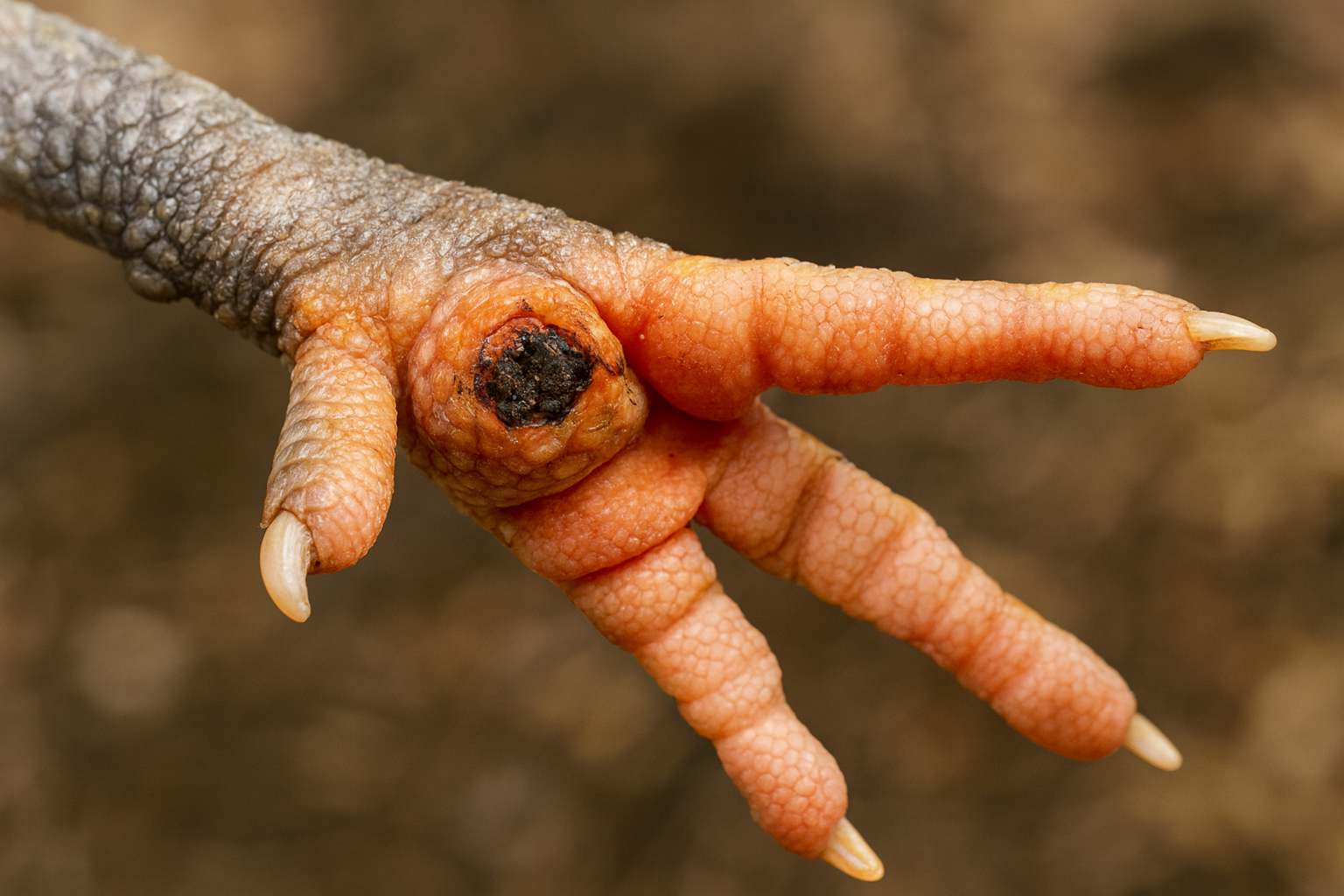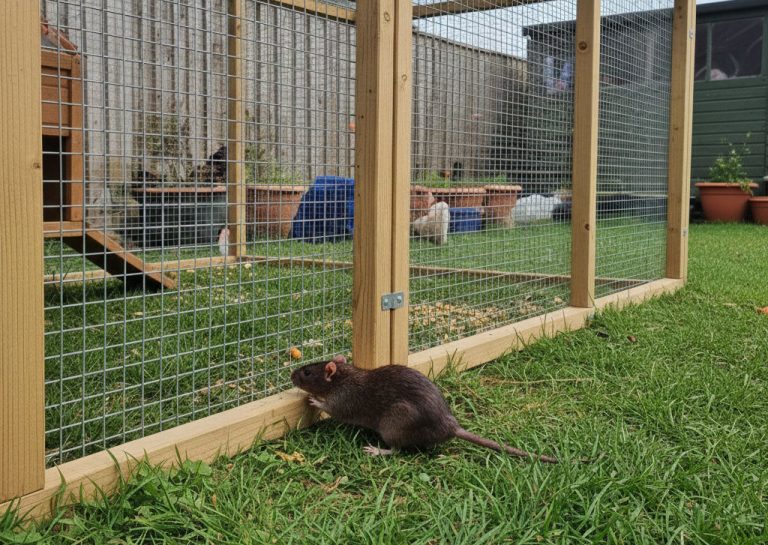Bumblefoot In Chickens: Causes, Symptoms And Treatment
Bumblefoot in chickens is one of those problems most keepers come across at some point. It can look dramatic, with that dark scab on the sole of the foot, and I know from experience it can make a hen limp badly. Left untreated it can become a very serious infection, but if you catch it early you can often deal with it before it causes too much trouble.
What bumblefoot actually is
Bumblefoot, or ulcerative pododermatitis if you want the vet’s term, is basically an infection in the soft pad of a chicken’s foot. It usually starts with a tiny cut or some repeated pressure, which allows bacteria to get in. Once it takes hold, the pad swells, feels hot to the touch and often develops that round, dark scab in the middle. It’s painful for the bird to walk on, and in bad cases the infection can spread deeper into the tissues or even the bone.
Why chickens get bumblefoot
There are a few common causes I’ve seen over the years. Sharp stones, bits of wire or rough ground in the run can nick the skin. High perches or awkward landings put extra pressure on the pads, and poorly designed perches can cause sores. Damp, dirty bedding softens the skin and makes it easier for infection to get in. And overweight hens are at greater risk because their feet are under more strain than they’re designed for.
Spotting the early signs
I always make a habit of checking feet whenever I pick up a hen. The first thing you notice with bumblefoot is usually a limp or a reluctance to jump down from the perch. On inspection, the foot often looks swollen or feels warmer than normal. That tell-tale black scab is a giveaway, though it’s worth remembering not every case has one straight away. Catching it early makes a huge difference to how easy it is to deal with.
For more information about spotting illness in hens, read my post: How To Tell If A Chicken Is Sick.
Caring for mild cases at home
For a hen that’s still walking fairly well and has only a small, early infection, I usually start with simple care. A soak in warm water with veterinary-grade Epsom salts softens the pad nicely. After drying the foot thoroughly, I’ll clean the area with a safe antiseptic such as Poultry First Aid Spray, then wrap it in a soft, sterile bandage to protect it. Keeping her on clean, dry bedding for a few days gives the foot a chance to heal. If I don’t see improvement after about five days, I take her to the vet rather than carry on hoping it will clear.
Bandaging tips from experience
When bandaging, I’ve found it helps to cut a small square of sterile gauze and place it over the sore before wrapping. That way the bandage doesn’t stick directly to the wound. I also use a little bit of padding underneath, because the aim is not just to keep dirt out but also to take the pressure off the sore pad. For wrapping, vet wrap is ideal as it sticks to itself without glue, but you need to be careful not to pull it too tight. I usually start below the toes, wrap gently around the pad and up over the ankle, then press the end down to hold it in place. Done properly, the bandage should stay on for a couple of days without slipping.
I change the dressing every two days, or sooner if it gets wet or dirty. Each time, I’ll repeat the soak and antiseptic clean before reapplying a fresh dressing. It is a bit of a faff, and some hens dislike being handled. If you stay calm and keep the process the same each time, they soon get used to it. Having a second pair of hands to hold the bird makes it much easier, especially with larger breeds.
In some cases, the scab softens and falls away on its own as the infection clears and the skin underneath heals. I never force it off, because pulling it can make the wound bleed and open up again. Instead, I just keep the routine going until the swelling reduces and the bird walks comfortably again.
When it’s time to see a vet
More advanced infections need professional treatment. Vets can surgically clean out the infected tissue and provide proper dressings, pain relief and antibiotics if necessary. I’ve seen people on forums talking about cutting out the scab or “kernel” themselves, but this really isn’t advised. Without anaesthetic, pain control and sterile conditions, it risks making the infection worse and causing unnecessary suffering. I’d always leave that kind of procedure to a vet.
Medicines and the law in the UK
Something worth knowing is that antibiotics for poultry are prescription-only here. They can only be supplied by a vet and, if you use them, you must follow withdrawal periods before eating or selling eggs. You also need to keep a note of what was given and when. It might sound like red tape, but it’s there to protect food safety and make sure antibiotics stay effective. So if you think your hen needs antibiotics, the only safe and legal route is through a vet who has actually inspected your hen, not an online store.
Preventing bumblefoot in the first place
Prevention is much easier than dealing with an infection. I always check that perches are the right width, smooth, and not set too high, so hens aren’t jumping down from a great height. Runs and coops need to be kept clean and reasonably dry, especially around feeders and drinkers where things get muddy quickly. Keeping hens at a healthy weight also helps, and I’ve found regular foot checks catch small problems before they turn into big ones.
Key takeaways
- Bumblefoot is a bacterial foot infection that causes swelling, pain and often a dark scab.
- Mild cases can respond to soaking, antiseptic cleaning and careful bandaging.
- UK vets advise against home surgery — severe cases need professional treatment.
- Antibiotics are prescription only in the UK, with strict egg withdrawal rules.
- Prevention relies on good perches, clean bedding, healthy weight and regular foot checks.
For advice on coop hygiene, read my post: 10 Tips for Safely Cleaning Your Chicken Coop.
Final thoughts
Bumblefoot in chickens can look alarming, but it’s manageable if you know what to do. A little at-home care can clear up mild cases, but anything more serious really does need veterinary attention. The good news is that with good coop design, clean ground, sensible perches and routine checks, it’s possible to reduce the risk significantly. Once you get into the habit of keeping an eye on feet, you’ll find you can stay ahead of the problem and keep your hens comfortable on their feet.
Disclaimer: This article is for information only and is not a substitute for professional veterinary advice.
Disclosure: This post may contain affiliate links. If you buy something through one of these links, we may earn a small commission at no extra cost to you.
Kevin O’Hara got his first chickens back in 1972. A backyard chicken keeper based in Yorkshire, he created of KeepingChickens.uk back in 2012. With years of hands-on experience, he shares practical, UK-specific advice to help others care for happy, healthy hens. Learn more about Kevin on the author page.





